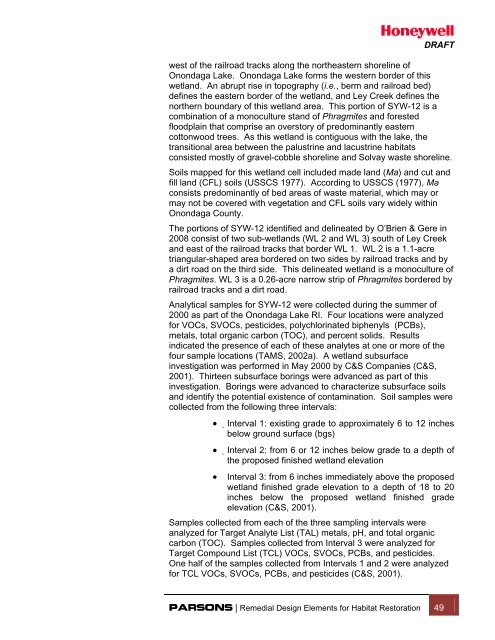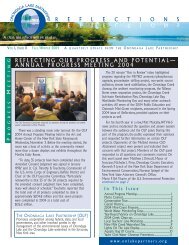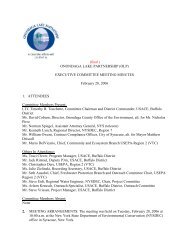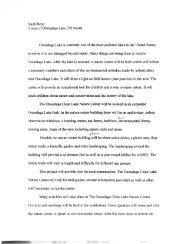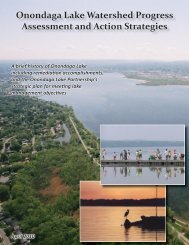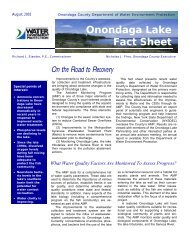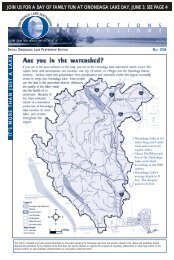Habitat Plan 2 - Onondaga Lake Partnership
Habitat Plan 2 - Onondaga Lake Partnership
Habitat Plan 2 - Onondaga Lake Partnership
You also want an ePaper? Increase the reach of your titles
YUMPU automatically turns print PDFs into web optimized ePapers that Google loves.
DRAFTwest of the railroad tracks along the northeastern shoreline of<strong>Onondaga</strong> <strong>Lake</strong>. <strong>Onondaga</strong> <strong>Lake</strong> forms the western border of thiswetland. An abrupt rise in topography (i.e., berm and railroad bed)defines the eastern border of the wetland, and Ley Creek defines thenorthern boundary of this wetland area. This portion of SYW-12 is acombination of a monoculture stand of Phragmites and forestedfloodplain that comprise an overstory of predominantly easterncottonwood trees. As this wetland is contiguous with the lake, thetransitional area between the palustrine and lacustrine habitatsconsisted mostly of gravel-cobble shoreline and Solvay waste shoreline.Soils mapped for this wetland cell included made land (Ma) and cut andfill land (CFL) soils (USSCS 1977). According to USSCS (1977), Maconsists predominantly of bed areas of waste material, which may ormay not be covered with vegetation and CFL soils vary widely within<strong>Onondaga</strong> County.The portions of SYW-12 identified and delineated by O’Brien & Gere in2008 consist of two sub-wetlands (WL 2 and WL 3) south of Ley Creekand east of the railroad tracks that border WL 1. WL 2 is a 1.1-acretriangular-shaped area bordered on two sides by railroad tracks and bya dirt road on the third side. This delineated wetland is a monoculture ofPhragmites. WL 3 is a 0.26-acre narrow strip of Phragmites bordered byrailroad tracks and a dirt road.Analytical samples for SYW-12 were collected during the summer of2000 as part of the <strong>Onondaga</strong> <strong>Lake</strong> RI. Four locations were analyzedfor VOCs, SVOCs, pesticides, polychlorinated biphenyls (PCBs),metals, total organic carbon (TOC), and percent solids. Resultsindicated the presence of each of these analytes at one or more of thefour sample locations (TAMS, 2002a). A wetland subsurfaceinvestigation was performed in May 2000 by C&S Companies (C&S,2001). Thirteen subsurface borings were advanced as part of thisinvestigation. Borings were advanced to characterize subsurface soilsand identify the potential existence of contamination. Soil samples werecollected from the following three intervals:• Interval 1: existing grade to approximately 6 to 12 inchesbelow ground surface (bgs)• Interval 2: from 6 or 12 inches below grade to a depth ofthe proposed finished wetland elevation• Interval 3: from 6 inches immediately above the proposedwetland finished grade elevation to a depth of 18 to 20inches below the proposed wetland finished gradeelevation (C&S, 2001).Samples collected from each of the three sampling intervals wereanalyzed for Target Analyte List (TAL) metals, pH, and total organiccarbon (TOC). Samples collected from Interval 3 were analyzed forTarget Compound List (TCL) VOCs, SVOCs, PCBs, and pesticides.One half of the samples collected from Intervals 1 and 2 were analyzedfor TCL VOCs, SVOCs, PCBs, and pesticides (C&S, 2001).PARSONS | Remedial Design Elements for <strong>Habitat</strong> Restoration 49


